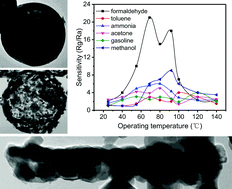Ag–LaFeO3 fibers, spheres, and cages for ultrasensitive detection of formaldehyde at low operating temperatures
Abstract
Metal oxide semiconductors with special structures and morphologies have attracted considerable attention because of their promising applications in gas sensors. In this paper, Ag–LaFeO3 fibers, spheres and cages have been prepared. Based on X-ray diffraction (XRD), scanning electron microscopy (SEM), energy dispersive X-ray spectrometry (EDS), Brunauer–Emmett–Teller (BET) nitrogen adsorption and transmission electron microscopy (TEM) observations, the structure and morphology of the products were characterized. It has been revealed that the as-prepared materials have uniform morphologies and consist of numerous nanocrystals. Sensors based on the Ag–LaFeO3 fibers, spheres and cages all exhibited high responses and good selectivities to formaldehyde gas. Owing to their hollow and porous structure, large surface area and greater number of surface active sites, the Ag–LaFeO3 cages have the lowest operating temperature. The results suggest that the as-prepared Ag–LaFeO3 fibers, spheres and cages, especially the cages, are promising candidates for high performance formaldehyde sensors.



 Please wait while we load your content...
Please wait while we load your content...